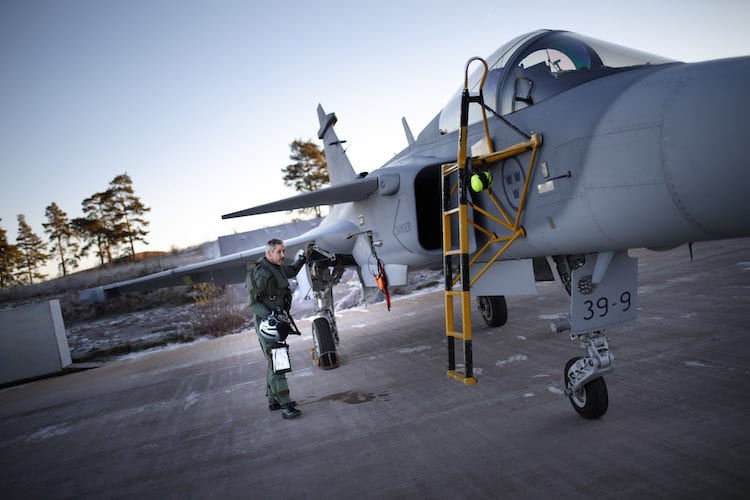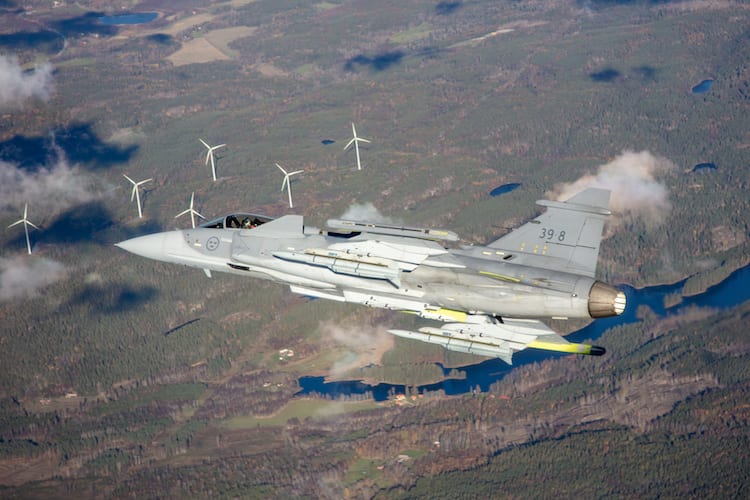
Saab Gripen E 39-9 test aircraft. (Saab)
Saab’s second Gripen E test aircraft, the 39-9, has entered the Swedish manufacturer’s flight test program — on the docket is its unique use of distributed integrated modular avionics (DIMA).
Test aircraft 39-9 completed its first flight Nov. 26, to become the first Gripen E test vehicle equipped with all of the communications, navigation and surveillance systems that will be featured on the new fighter jet when it achieves a targeted first delivery in 2019.
On the Gripen E, Saab is using a unique DIMA platform software layer that allows all of the aircraft’s line replaceable units (LRUs) to effectively function as one system.
Johan Segertoft, development leader for the Gripen E program at Saab, spoke with AVI after the 39-9’s first flight about how the fighter jet uses a unique data data-driven architecture and features unique technologies and materials designed to reduce weight and improve the design and development process.
How is Saab using an agile approach toward the integration of avionics hardware and software systems on the Gripen E?
With the new systems architecture and avionics in Gripen E integration of sensors and actuators is performed in a layered manner rather than the more traditional “silo” structure. That is, when basic integration from a physical perspective is done, the software interfaces are made available to the system and from that point value can be created by software applications which can be introduced in an agile manner.

A Gripen E in flight. (Saab)
One of the major technologies we have been covering in commercial aviation this year is the use of satellite- or air-to-ground connectivity allowing pilots to get weather updates and other information in the cockpit. What type of connectivity is featured on the Gripen E?
Gripen has demonstrated satcom functionality and the Gripen system have a wide capability of encrypted voice and data communication integrated for future demanding operations.
Can you explain how DIMA enables the Gripen’s LRUs to function as one system?
The DIMA system enables a level of abstraction. So from a software application perspective, you can develop code once without modifications based on deployment, and deployment can be in any of the LRUs of the system, which is governed by data driven configuration, or HIL, MIL, SIL installments.
Basically, from a logical perspective, you are working towards one system with the same set of rules and possibilities. This provide a lot of benefits in terms of verification and validation when you are able to run the exact same code towards the same application programmable interfaces in all environments irrespective of hardware or even operating systems.
There are a lot of key capabilities with the avionics platform, safe partitioning and flexible deployment being some obvious ones, but the ability to reconfigure the system with ease and very low impact in terms of reverification, even for safety critical applications, is probably one of the more important of all its unique features.
What are some of the innovative new technologies or materials featured on the Gripen E?
One area of interest, as it is for all aircraft programs, is to find ways to reduce weight. In Gripen E we have introduced aluminum lithium as an alloy for the structural parts, that allows for weight saving. Another technology is additive manufacturing, that has been used for some structural parts also with the intention to reduce weight with an improve functionality as well.
What about on the design and development side of the program?
We are testing the ability to digitalize the design and production of Gripen E. We are only using digital drawings and working instructions, and the improvement in production with respect to fit between articles and perfection in production is significantly improved. We are now exploring the use of augmented reality and remote guidance in production and support, which will further improve the ability to work with the exact same information at all stages.
What will the Gripen E flight testing program focus on moving forward?
After the first flight with 39-9 in November, the flight test program continues and more flight tests will be completed according to our schedule. Now we are testing the tactical systems and sensors.
The objective of the coming flights is to open up the flight envelope and verify the computer models used in the development of the aircraft. Besides that, we have been flying with external stores with 39-8 since July. In October, we conducted successful separation tests with external stores and external fuel tank on 39-8. In November we completed a test flight by 39-8 with the Meteor Beyond Visual Range Air-to-Air Missile (BVRAAM) for the first time.